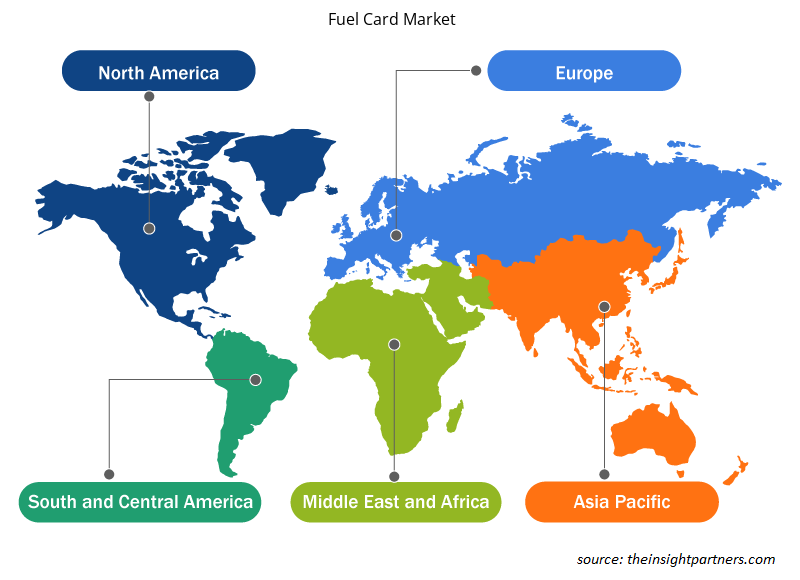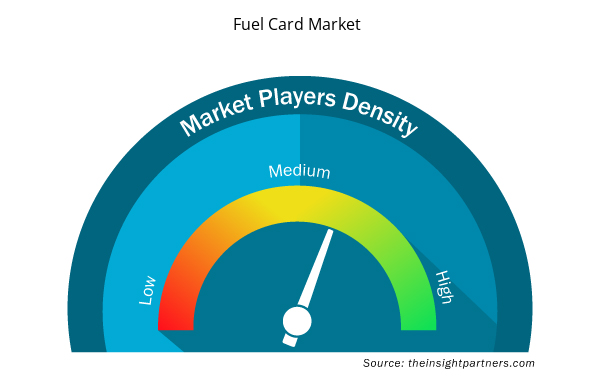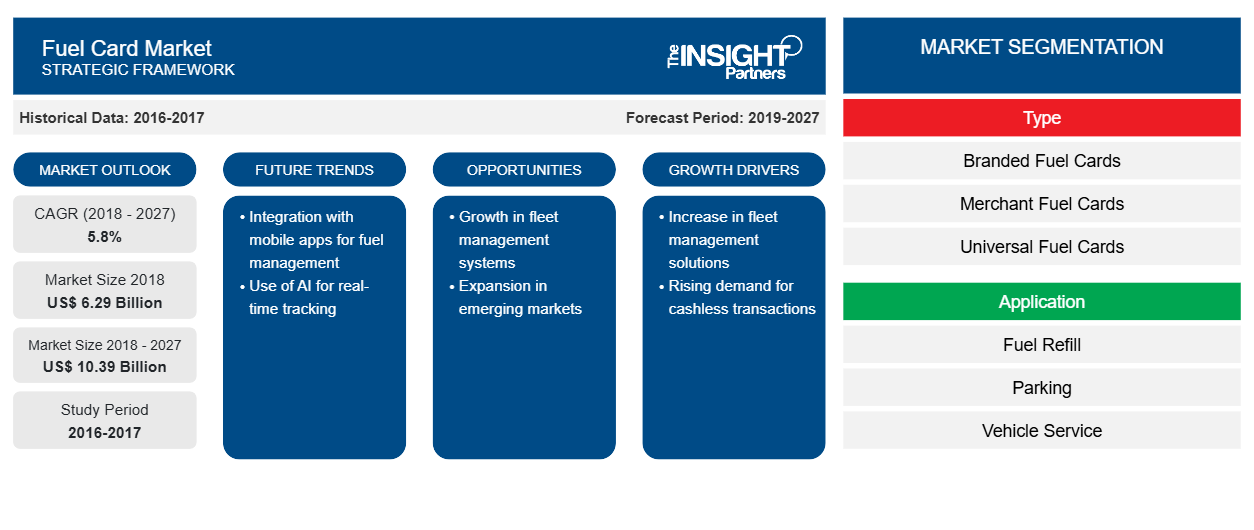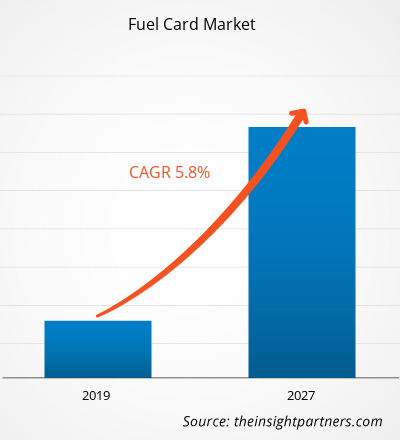[Forschungsbericht] Der globale Tankkartenmarkt wird im Jahr 2018 auf 6,29 Milliarden US-Dollar geschätzt und soll im Prognosezeitraum 2019 – 2027 mit einer durchschnittlichen jährlichen Wachstumsrate von 5,8 % wachsen und bis 2027 einen Wert von 10,39 Milliarden US-Dollar erreichen .
Die Region Nordamerika hat einen erheblichen Marktanteil in Bezug auf den Umsatz mit Tankkarten und wird voraussichtlich auch im Prognosezeitraum den Marktanteil dominieren. Universalkarten sind die bequemste Art von Tankkarten. Die Anbieter dieser Karten arbeiten normalerweise mit mehreren Tankkartenunternehmen zusammen und bieten große Flexibilität. Bestimmte Tankkartenunternehmen sind nur in einigen Ländern oder Regionen tätig, während andere nur an bestimmten Tankstellen akzeptiert werden. Benutzer mit weniger Optionen in ihrer Region sollten vorsichtig sein, wenn sie sich nicht auf nur wenige Tankstellen beschränken.
Einblicke in den Tankkartenmarkt
Effiziente Flottenverwaltung durch verbesserte Datenerfassung
Tankkarten ermöglichen eine bessere Nachverfolgung der Flottenkosten und der Effizienz der Flotte, indem sie den Kilometerstand und den Kraftstoffverbrauch der Fahrzeuge in einer Flotte in Echtzeit verfolgen. Flottenbetreiber verwenden Tankkarten für Kosten wie LKW-Wartung, LKW-Reparaturen, Kraftstoff, LKW-Reinigung und Ersatzfahrzeugmiete, um nur einige zu nennen. Zu den von einer Tankkarte erfassten Daten gehören Kilometerstand, Kraftstoffqualitäten, Kraftstoffprodukt und Kraftstoffmenge, Fahrzeug-ID, Fahrer-ID und Steuerinformationen sowie Transaktionsdetails wie Zeit, Ort, Ausgabebetrag und Datum, die Flottenmanager bei der umfassenden Umrüstung unterstützen . Dieser Faktor wird die Nachfrage auf dem Tankkartenmarkt im Prognosezeitraum ankurbeln.
Passen Sie diesen Bericht Ihren Anforderungen an
Sie erhalten kostenlose Anpassungen an jedem Bericht, einschließlich Teilen dieses Berichts oder einer Analyse auf Länderebene, eines Excel-Datenpakets sowie tolle Angebote und Rabatte für Start-ups und Universitäten.
- Holen Sie sich die wichtigsten Markttrends aus diesem Bericht.Dieses KOSTENLOSE Beispiel umfasst eine Datenanalyse von Markttrends bis hin zu Schätzungen und Prognosen.
Geringeres Betrugsrisiko bei der Nutzung von Tankkarten
Die Verwendung von Tankkarten bietet Vorteile in Bezug auf Funktionalität und Sicherheit im Vergleich zu alternativen Zahlungsmethoden für Kraftstoff wie Portokasse. Karten können mit dem Fahrzeugkennzeichen oder dem Namen des Fahrers und dem Firmennamen bedruckt werden, was zusätzlichen Schutz vor betrügerischer Verwendung oder Karten zum Tanken bietet. Umfassende Informationen zu allen Tankvorgängen verringern das Risiko von Missbrauch durch Mitarbeiter und bieten eine bessere Kontrolle über die tatsächliche Fahrzeugnutzung. Daher wird erwartet, dass der Tankkartenmarkt weltweit wachsen wird.
Einblicke in das Typsegment
Der Tankkartenmarkt ist nach Komponenten segmentiert in Markentankkarten, Händlertankkarten und Universaltankkarten. Tankkarten werden üblicherweise von KMU und großen Unternehmen verwendet, um ihren Kraftstoffverbrauch zu verfolgen und bequem bargeldlos zu bezahlen. Solche Karten werden am häufigsten von Unternehmen oder Organisationen verwendet, die sich mit Transport und Flottenmanagement befassen. Verschiedene in diesem Bereich tätige Unternehmen bieten unterschiedliche Kartentypen an. Diese Karten werden neben dem Tanken auch für verschiedene andere Zwecke verwendet. Tankkarten können je nach Herausgeber im Großen und Ganzen unabhängig oder markengebunden sein.
Einblicke in Anwendungssegmente
Der globale Tankkartenmarkt ist nach Anwendung segmentiert in Tanken, Parken, Fahrzeugservice, Maut und andere. Eine Tankkarte ermöglicht es Benutzern und Geschäftsinhabern, Kraftstoff- und Wartungskosten zu verwalten und zu kontrollieren. Sie werden im Allgemeinen als Zahlungskarte für Kraftstoffe an Tankstellen verwendet. Darüber hinaus können diese Karten auch zur Bezahlung anderer Fahrzeugservices wie Reparaturen, Wartung sowie Pannenhilfe verwendet werden. Dank umfassender Berichterstattung ermöglichen mehrere Tankkarten den Benutzern, Echtzeitberichte zu erhalten, sodass sie über alle Geschäftsausgaben auf dem Laufenden bleiben und die Kfz-Steuern verwalten können.
Regionale Einblicke in den Tankkartenmarkt
Die regionalen Trends und Faktoren, die den Tankkartenmarkt im Prognosezeitraum beeinflussen, wurden von den Analysten von Insight Partners ausführlich erläutert. In diesem Abschnitt werden auch die Marktsegmente und die geografische Lage von Tankkarten in Nordamerika, Europa, im asiatisch-pazifischen Raum, im Nahen Osten und Afrika sowie in Süd- und Mittelamerika erörtert.

- Erhalten Sie regionale Daten zum Tankkartenmarkt
Umfang des Tankkartenmarktberichts
| Berichtsattribut | Details |
|---|---|
| Marktgröße im Jahr 2018 | 6,29 Milliarden US-Dollar |
| Marktgröße bis 2027 | 10,39 Milliarden US-Dollar |
| Globale CAGR (2018 - 2027) | 5,8 % |
| Historische Daten | 2016-2017 |
| Prognosezeitraum | 2019–2027 |
| Abgedeckte Segmente | Nach Typ
|
| Abgedeckte Regionen und Länder | Nordamerika
|
| Marktführer und wichtige Unternehmensprofile |
|
Dichte der Akteure auf dem Tankkartenmarkt: Die Auswirkungen auf die Geschäftsdynamik verstehen
Der Markt für Tankkarten wächst rasant, angetrieben durch die steigende Nachfrage der Endnutzer aufgrund von Faktoren wie sich entwickelnden Verbraucherpräferenzen, technologischen Fortschritten und einem größeren Bewusstsein für die Vorteile des Produkts. Mit der steigenden Nachfrage erweitern Unternehmen ihr Angebot, entwickeln Innovationen, um die Bedürfnisse der Verbraucher zu erfüllen, und nutzen neue Trends, was das Marktwachstum weiter ankurbelt.
Die Marktteilnehmerdichte bezieht sich auf die Verteilung der Firmen oder Unternehmen, die in einem bestimmten Markt oder einer bestimmten Branche tätig sind. Sie gibt an, wie viele Wettbewerber (Marktteilnehmer) in einem bestimmten Marktraum im Verhältnis zu seiner Größe oder seinem gesamten Marktwert präsent sind.
Die wichtigsten auf dem Tankkartenmarkt tätigen Unternehmen sind:
- BP PLC
- Exxon Mobil Corporation
- Fleetcor Technologies, Inc.
- Royal Dutch Shell plc
- US-Bank
Haftungsausschluss : Die oben aufgeführten Unternehmen sind nicht in einer bestimmten Reihenfolge aufgeführt.

- Überblick über die wichtigsten Akteure auf dem Tankkartenmarkt
Einige der Marktinitiativen erwiesen sich als die am häufigsten angewandte Strategie auf dem globalen Tankkartenmarkt. Nachfolgend sind einige der jüngsten Marktinitiativen aufgeführt:
2019: Edenred Capital Partners investiert in innovative Unternehmen mit hohem Wachstumspotenzial in Bereichen, die mit den Aktivitäten von Edenred in Zusammenhang stehen. Ziel ist es, das Ökosystem der Gruppe durch die Initiierung wertvoller Synergien mit den unterstützten Unternehmen zu verbessern.
2018: Edenred, der weltweit führende Anbieter von Transaktionslösungen für Unternehmen, Mitarbeiter und Händler, gab heute die Unterzeichnung einer Vereinbarung zur Übernahme von 80 % des Aktienkapitals der Gruppe The Right Fuelcard Company (TRFC) bekannt, dem viertgrößten Tankkartenprogrammmanager im Vereinigten Königreich.
GLOBALE TANKKARTENMARKTSEGMENTIERUNG
Globaler Tankkartenmarkt – nach Typ
- Tankkarten mit Ihrem Logo
- Tankkarten mit Händlerlogo
- Universelle Tankkarten
Globaler Tankkartenmarkt – nach Anwendung
- Kraftstoff nachfüllen
- Parken
- Fahrzeugservice
- Mautgebühren
- Sonstiges
Globaler Tankkartenmarkt – nach Geografie
Nordamerika
- UNS
- Kanada
- Mexiko
Europa
- Frankreich
- Deutschland
- Italien
- Vereinigtes Königreich
- Spanien
- Restliches Europa
Asien-Pazifik (APAC)
- China
- Indien
- Japan
- Australien
- Restlicher Asien-Pazifik-Raum
Naher Osten und Afrika (MEA)
- Saudi-Arabien
- Vereinigte Arabische Emirate
- Südafrika
- Restlicher Naher Osten und Afrika
Südamerika
- Brasilien
- Restliches Südamerika
Globaler Tankkartenmarkt – Firmenprofile
- BP PLC
- Exxon Mobil Corporation
- Fleetcor Technologies, Inc.
- Royal Dutch Shell plc
- US-Bank
- Wex Inc.
- DKV
- Weltweite Kraftstoffdienstleistungen
- Edenerd
- Radius-Zahlungslösungen.
Allstar, Arco, Caltex, Chevron Texaco, Commdel, EDC, Engen Petroleum Ltd., FastFuel, Fleetcare Pty Ltd, fuelGenie und Fuelman sind einige weitere Marktteilnehmer aus der Wertschöpfungskette, die im Bericht nicht aufgeführt sind, aber auf Anfrage aufgenommen werden können.
- Historische Analyse (2 Jahre), Basisjahr, Prognose (7 Jahre) mit CAGR
- PEST- und SWOT-Analyse
- Marktgröße Wert/Volumen – Global, Regional, Land
- Branche und Wettbewerbsumfeld
- Excel-Datensatz


- Biopharmaceutical Tubing Market
- Workwear Market
- Emergency Department Information System (EDIS) Market
- Drain Cleaning Equipment Market
- Industrial Inkjet Printers Market
- Space Situational Awareness (SSA) Market
- Organoids Market
- Toothpaste Market
- Wind Turbine Composites Market
- Photo Editing Software Market

Report Coverage
Revenue forecast, Company Analysis, Industry landscape, Growth factors, and Trends

Segment Covered
This text is related
to segments covered.

Regional Scope
North America, Europe, Asia Pacific, Middle East & Africa, South & Central America

Country Scope
This text is related
to country scope.
Trends and growth analysis reports related to Banking, Financial Services, and Insurance : READ MORE..
The List of Companies
- BP P.L.C.
- Exxon Mobil Corporation
- Fleetcor Technologies, Inc.
- Royal Dutch Shell plc
- U.S. Bank
- Wex Inc.
- DKV
- World Fuel Services
- Edenerd
- Radius Payment Solutions
The Insight Partners performs research in 4 major stages: Data Collection & Secondary Research, Primary Research, Data Analysis and Data Triangulation & Final Review.
- Data Collection and Secondary Research:
As a market research and consulting firm operating from a decade, we have published and advised several client across the globe. First step for any study will start with an assessment of currently available data and insights from existing reports. Further, historical and current market information is collected from Investor Presentations, Annual Reports, SEC Filings, etc., and other information related to company’s performance and market positioning are gathered from Paid Databases (Factiva, Hoovers, and Reuters) and various other publications available in public domain.
Several associations trade associates, technical forums, institutes, societies and organization are accessed to gain technical as well as market related insights through their publications such as research papers, blogs and press releases related to the studies are referred to get cues about the market. Further, white papers, journals, magazines, and other news articles published in last 3 years are scrutinized and analyzed to understand the current market trends.
- Primary Research:
The primarily interview analysis comprise of data obtained from industry participants interview and answers to survey questions gathered by in-house primary team.
For primary research, interviews are conducted with industry experts/CEOs/Marketing Managers/VPs/Subject Matter Experts from both demand and supply side to get a 360-degree view of the market. The primary team conducts several interviews based on the complexity of the markets to understand the various market trends and dynamics which makes research more credible and precise.
A typical research interview fulfils the following functions:
- Provides first-hand information on the market size, market trends, growth trends, competitive landscape, and outlook
- Validates and strengthens in-house secondary research findings
- Develops the analysis team’s expertise and market understanding
Primary research involves email interactions and telephone interviews for each market, category, segment, and sub-segment across geographies. The participants who typically take part in such a process include, but are not limited to:
- Industry participants: VPs, business development managers, market intelligence managers and national sales managers
- Outside experts: Valuation experts, research analysts and key opinion leaders specializing in the electronics and semiconductor industry.
Below is the breakup of our primary respondents by company, designation, and region:

Once we receive the confirmation from primary research sources or primary respondents, we finalize the base year market estimation and forecast the data as per the macroeconomic and microeconomic factors assessed during data collection.
- Data Analysis:
Once data is validated through both secondary as well as primary respondents, we finalize the market estimations by hypothesis formulation and factor analysis at regional and country level.
- Macro-Economic Factor Analysis:
We analyse macroeconomic indicators such the gross domestic product (GDP), increase in the demand for goods and services across industries, technological advancement, regional economic growth, governmental policies, the influence of COVID-19, PEST analysis, and other aspects. This analysis aids in setting benchmarks for various nations/regions and approximating market splits. Additionally, the general trend of the aforementioned components aid in determining the market's development possibilities.
- Country Level Data:
Various factors that are especially aligned to the country are taken into account to determine the market size for a certain area and country, including the presence of vendors, such as headquarters and offices, the country's GDP, demand patterns, and industry growth. To comprehend the market dynamics for the nation, a number of growth variables, inhibitors, application areas, and current market trends are researched. The aforementioned elements aid in determining the country's overall market's growth potential.
- Company Profile:
The “Table of Contents” is formulated by listing and analyzing more than 25 - 30 companies operating in the market ecosystem across geographies. However, we profile only 10 companies as a standard practice in our syndicate reports. These 10 companies comprise leading, emerging, and regional players. Nonetheless, our analysis is not restricted to the 10 listed companies, we also analyze other companies present in the market to develop a holistic view and understand the prevailing trends. The “Company Profiles” section in the report covers key facts, business description, products & services, financial information, SWOT analysis, and key developments. The financial information presented is extracted from the annual reports and official documents of the publicly listed companies. Upon collecting the information for the sections of respective companies, we verify them via various primary sources and then compile the data in respective company profiles. The company level information helps us in deriving the base number as well as in forecasting the market size.
- Developing Base Number:
Aggregation of sales statistics (2020-2022) and macro-economic factor, and other secondary and primary research insights are utilized to arrive at base number and related market shares for 2022. The data gaps are identified in this step and relevant market data is analyzed, collected from paid primary interviews or databases. On finalizing the base year market size, forecasts are developed on the basis of macro-economic, industry and market growth factors and company level analysis.
- Data Triangulation and Final Review:
The market findings and base year market size calculations are validated from supply as well as demand side. Demand side validations are based on macro-economic factor analysis and benchmarks for respective regions and countries. In case of supply side validations, revenues of major companies are estimated (in case not available) based on industry benchmark, approximate number of employees, product portfolio, and primary interviews revenues are gathered. Further revenue from target product/service segment is assessed to avoid overshooting of market statistics. In case of heavy deviations between supply and demand side values, all thes steps are repeated to achieve synchronization.
We follow an iterative model, wherein we share our research findings with Subject Matter Experts (SME’s) and Key Opinion Leaders (KOLs) until consensus view of the market is not formulated – this model negates any drastic deviation in the opinions of experts. Only validated and universally acceptable research findings are quoted in our reports.
We have important check points that we use to validate our research findings – which we call – data triangulation, where we validate the information, we generate from secondary sources with primary interviews and then we re-validate with our internal data bases and Subject matter experts. This comprehensive model enables us to deliver high quality, reliable data in shortest possible time.


 Holen Sie sich ein kostenloses Muster für diesen Bericht
Holen Sie sich ein kostenloses Muster für diesen Bericht